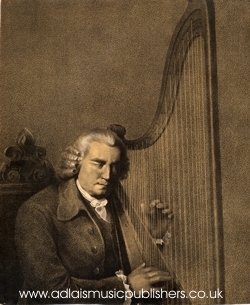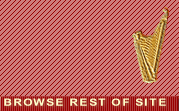JOHN
PARRY
Parri
Ddall/Blind Parry
(1710-1782)
 Bewigged
and powdered, John Parry was a Master of the High Baroque. Born
in about 1710, and almost certainly on the Cefn Amwlch estate
at Bryn Cynan on the Lleyn Peninsula, he was blind from birth.
His first patrons were the Griffiths family, owners of the estate,
and they provided the young blind boy with the harp which was
to give him the means of making a livelihood. This was a Welsh
triple harp, and John Parry played it in the traditional manner,
resting it on his left shoulder, the left hand playing the treble,
and the right hand playing the bass.
Bewigged
and powdered, John Parry was a Master of the High Baroque. Born
in about 1710, and almost certainly on the Cefn Amwlch estate
at Bryn Cynan on the Lleyn Peninsula, he was blind from birth.
His first patrons were the Griffiths family, owners of the estate,
and they provided the young blind boy with the harp which was
to give him the means of making a livelihood. This was a Welsh
triple harp, and John Parry played it in the traditional manner,
resting it on his left shoulder, the left hand playing the treble,
and the right hand playing the bass.
During
the eighteenth-century, the only possible way of making a professional
career as a harpist was to find oneself a wealthy patron, and by
the late 1730s John Parry had gained the patronage of the family
in whose employ he was to remain for the rest of his life. This
was the family of Sir Watkin Williams Wynn, whose family seat was
Wynnstay, near Ruabon. As a Member of Parliament, Sir Watkin kept
a house in London as well, and he would have taken his retinue,
which included his harpist, from one house to another with him.
Thus John Parry spent a great deal of time in London and mixed
in the cultural and artistic circles of his day. His first publication
was his ‘Antient Welsh Airs by the Bards of Wales’ (1742),
and such was the pride of his patron Sir Watkin Williams Wynn in
the preeminence of his harpist that he subscribed to no fewer than
ten copies of the book.
John
Parry’s concert career does not seem to have been much hampered
by his blindness. There are accounts of his concerts in London,
Cambridge, Oxford, Leeds and Dublin, and on 27 February and 1 March
1741 he played Handel’s Concerto in B flat at Hickford’s
Great Room in Brewer Street, Soho.
In
1750 the harpist William Powel died. He was the harpist who,
fourteen years before, had given the first performance of Handel’s
Concerto, and who, at the time of his death was harpist to Frederick,
Prince of Wales. “Race to London like a greyhound after a
hare, and there is no doubt but that you will obtain the prize
you so richly deserve”, urged his friend Richard Morris. “Refuse
not your due honour when it be offered unto you”, he continued.
But to no avail. There is no record of John Parry’s ever
having hankered after a Royal Appointment, or being offered one
despite his distinction.
In
1757, it was John Parry’s playing which inspired the poet Thomas
Gray to finish his Ode ‘The Bard’ and no doubt it is
his noble playing which is commemorated in the lines “And
with a master’s hand and prophet’s fire/ Struck the
deep sorrows of his lyre”. It is for his ‘Lessons’ or
Sonatas for the Harp (Adlais Catalogue
no. 39) that John Parry
is best remembered today. These were published along with a second
collection of ‘Welsh, English and Scotch Airs with new Variations’ in
1761. He was admitted to the élite circle of the Royal Society
of Musicians in 1763, and he knew many distinguished people like
Sir Joshua Reynolds, the painter, and Sir David Garrick, the actor – rather
to the resentment of some of his Welsh friends who considered him
haughty, disdainful and cold. He published another collection of ‘Antient
Airs’ in 1781. This one was called ‘British Harmony’,
and dedicated to Sir Watkin Williams Wynn II, son of his previous
patron.
John
Parry died on 7 October 1782, and the engraving* reproduced in
the ‘Gentleman’s Magazine’ after his death is
eloquent enough testimony to the esteem in which he was held, as
an influential and greatly respected musical figure.
*reproduced
on the cover and inside pages of Adlais’s facsimile edition
of the Four Lessons/Sonatas.
A
portrait painted by his son, William Parry, once hung in Lady
Llanover’s
home (www.ladyllanover.org.uk) and the triple harp which he played
in 1755 has been reproduced by Christopher Barlow (www.barlowharps.demon.co.
uk) , and is now owned and played by Ann Griffiths.
Two
other composer-harpists named John Parry are represented in the
Adlais Catalogue, viz. John Parry (Bardd Alaw) (1776-1851), and
his son John Orlando Parry (1810-1879).
©
Ann Griffiths 2005
